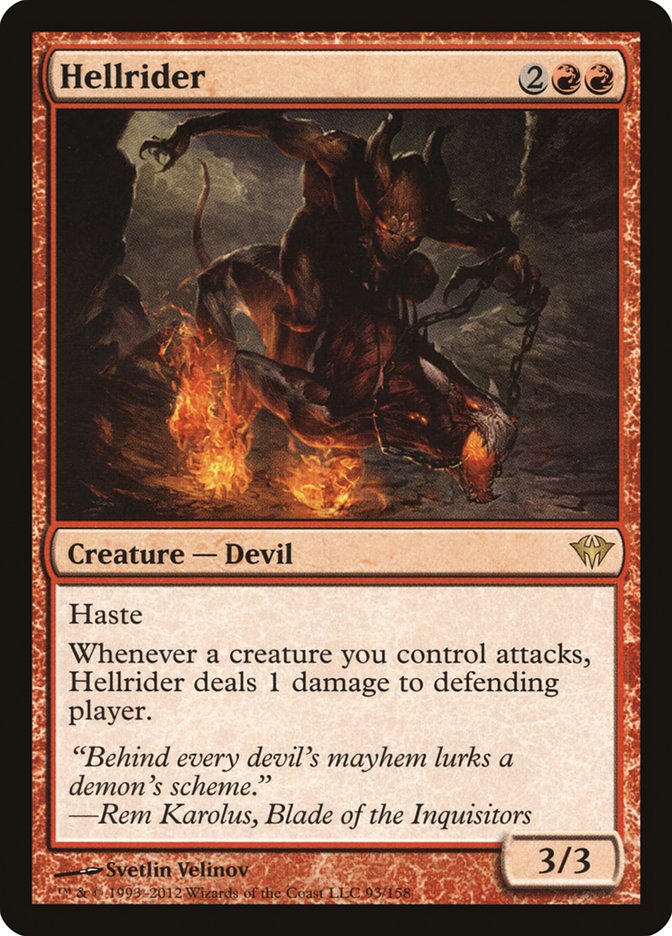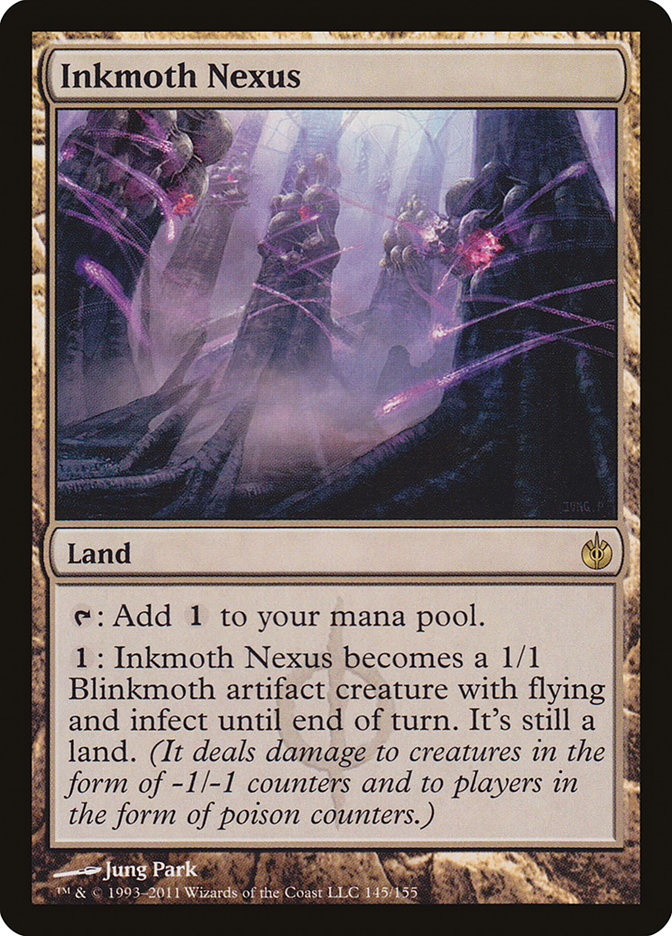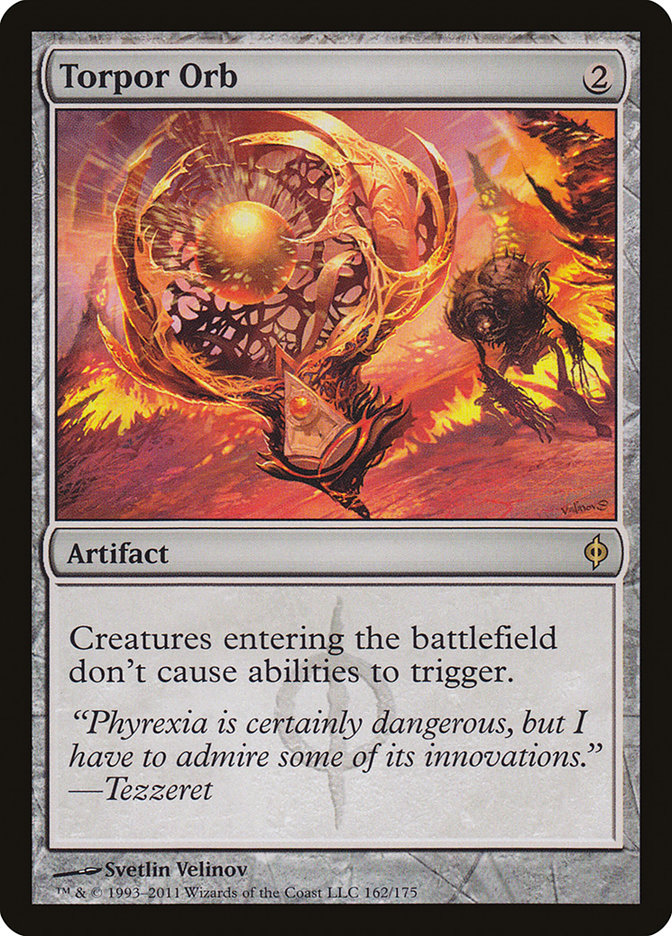The Gleeful Flames Event Deck which released alongside Magic the Gathering’s Dark Ascension set is a Mono-Red deck built around dealing tons of direct damage. In January 2024, almost a dozen years after its 2012 release, though, it’s actually valuable in terms of cards within it, especially thanks to a certain artifact in the included 15-card sideboard.
Today on Toolbox Theory, let’s look at both the deck on its own, as well as what’s useful to take away from the deck for use in today’s Magic world. Will we prove today’s theory of this being a good value buy for Magic the Gathering players in 2024?
Gleeful Flames Event Deck (Dark Ascension Era Standard)

Creatures (20)
- 4 Forge Devil
- 4 Goblin Arsonist
- 4 Goblin Fireslinger
- 4 Goblin Gaveleer
- 1 Hellrider
- 3 Torch Fiend
Non-Creature Spells (28)
- 4 Artillerize
- 4 Brimstone Volley
- 1 Curse of Stalked Prey
- 2 Faithless Looting
- 4 Goblin Grenade
- 3 Infiltration Lens
Lands (22)
- 3 Haunted Fengraf
- 2 Inkmoth Nexus
- 17 Mountain
Creature Analysis
The creature line-up in this deck is very simple. They’re all small creatures that can do more damage than their initial mana cost may suggest. Forge Devil is good for taking out your opponent’s smaller creatures, but at the cost of 1 damage to you. Goblin Arsonist is a bit better card, as it deals 1 damage to either a target creature or player when it dies (giving it great synergy with Goblin Grenade!)
Goblin Fireslinger has a tap ability to deal one damage to a target player; it’s an okay ability, but nothing special. However, it’s a Goblin for Grenade, so it’s worth including. Goblin Gaveleer is a little 1/1 with Trample that gains +2/+0 for each equipment attached to it; we’ll see how it’s good with Infiltration Lens later. Torch Fiend is a solid two-mana 2/1 body that can sacrifice itself for artifact removal.

Hellrider is the boss monster of the deck. It’s a very good rare from Dark Ascension that not only is a 3/3 with haste, but it also causes 1 damage to your opponent each time one of your creatures declares an attack, making all of your little Goblins much more dangerous. I would’ve preferred at least one more copy of this rare, if not two. It should be at the heart of this strategy. (You could buy two copies of the event deck, of course, as a particular non-basic land included in this package will prove worth the cost in doing so.)
Non-Creature Spell Analysis
For the non-creature spells, you have a full playset (four copies) of the four-mana instant Artillerize. With it, you sacrifice a creature and deal 5 damage to a target player or creature. So, when your little Goblins outlive their usefulness, this card really comes in handy. While 4 mana is kind of steep for 5 damage, being instant speed and sacrificing Goblins that can cause additional damage makes this definitely playable.
Brimstone Volley is a three-mana burn spell for 3 damage that can deal 5 damage with its Morbid ability. Morbid activates whenever a creature died that turn (yours or an opponents). This makes it combo very well with Artillerize, and with cards like Torch Fiend that can sacrifice themselves for an effect.
Speaking of sacrifices, Goblin Grenade may be the best card in the deck, allowing you to for one mana and the sacrifice of a little Goblin to do 5 damage to anything. Printed all the way back in Fallen Empires, it continues to pull its weight in Goblin decks even in 2024! Five damage for one mana, even with a sacrifice, is as powerful as you get for cheap burn spells!
Infiltration Lens is an interesting little equipment that draws you two cards any time an attacking creature becomes blocked. It’s just a single mana to cost and a single mana to equip, making Goblin Gaveleer more of a threat. The lens allows for easy cheap card draw to keep you ahead of your opponent in card advantage. It’s also a really good card in the Commander format.
Curse of Stalked Prey is one of the more underrated curse cards which allows your creatures to gain +1/+1 counters each time they deal combat damage to the enchanted player. It’s surprisingly effective for just two mana, even if it’s probably not necessary as a one-of in this deck.
Lastly, we have the always useful Faithless Looting. It allows you to draw a couple of cards and discard two cards that aren’t currently useful to you, and it also has flashback, meaning you could easily discard the second copy of Looting if you draw it and use it again later.
For the mana base, we have 17 mountains and five non-basic lands. We have three copies of Haunted Fengraf , which is interesting in that it can get creatures back to your hand from the graveyard by sacrificing it and paying three generic mana. The only time that this would seem necessary, however, is if your Hellrider is destroyed and it’s the only creature in your graveyard. That mana would be better spent elsewhere, it seems.

However, the 2 Inkmoth Nexus are an interesting inclusion. They don’t seem to fit into the general theme of the deck, but replacing two copies of the Fengraf for 2 more Nexus could make for an onslaught of flying infect creatures. It’s a curious choice for this deck, though. As I hinted at earlier, I think that these were included simply because they were hot cards at the time which would make the event deck sell. It was a wise choice; it’s still great today!
Even better, these Event Decks came with a tournament-ready 15-card sideboard. Three of the cards are valuable today!
Sideboard Analysis
- 2 Act of Treason
- 4 Arc Trail
- 1 Dismember
- 2 Gut Shot
- 3 Into the Core
- 3 Torpor Orb
Sideboard
Back when I first reviewed the deck back in 2016, I felt that the Arc Trails and Gut Shots were better suited for the main deck. Arc Trail was a really good burn card in its heyday for two mana: it deals 2 damage to a target creature or player and 1 damage to another target creature or player. It was often a pretty solid two-for-one, and it saw play in Modern for quite a number of years. Heck, it still sees Commander play!
Into the Core was nice artifact removal in Standard; it was four mana, but it exiled two target artifacts at instant speed. The one copy of Dismember can help with taking out an opposing threat; it’s still played in Modern and Legacy to this day. While having to pay 4 life with the Phyrexian mana symbols is painful — since you have no access to Black mana — sometimes it’s worth the cost.
The two copies of Act of Treason help you against decks with big creatures that would otherwise hamper you, or against aggro mirrors in taking their best creature. In either case, they can help you swing for game. There are better versions of this same effect in 2024, but it’s still solid.

Torpor Orb is a great inclusion for the deck as well, shutting down pesky enter the battlefield effects. Over the years, it’s become a Legacy tournament staple and having three copies isn’t just good for the deck’s playability — even in 2024 Modern it’s a legitimate sideboard option — but also its overall market value.
Deck Strategy and Game Theory
As a Magic: The Gathering deck from 2012, this was a serviceable Red Aggro/Burn deck, focusing on dealing quick damage to the opponent through a combination of aggressive creatures and direct damage spells. Let’s analyze its game theory and strategy components:
Aggressive Creature Strategy: The deck contains low-cost creatures like Forge Devil, Goblin Arsonist, and Goblin Fireslinger, designed to apply early pressure on the opponent. These creatures are meant to deal damage quickly and often have abilities that deal additional damage when they enter the battlefield or die.
Direct Damage Spells: Cards like Brimstone Volley, Goblin Grenade, and Artillerize allow for direct damage to be dealt to the opponent or their creatures. This contributes to the deck’s strategy of quickly reducing the opponent’s life total.
Combo Potential: Certain card combinations in this deck can lead to significant damage outputs. For example, Goblin Gaveleer equipped with Infiltration Lens can become a major threat, especially if the opponent chooses to block it, triggering the Lens’s ability to draw cards.
Versatility in Creature Removal: Cards like Forge Devil and Torch Fiend offer utility in removing small creatures from the board, particularly useful against other creature-based aggro decks.
Flexibility and Card Advantage: Faithless Looting provides card selection and draw, allowing the player to sift through the deck for needed components, increasing consistency and adaptability.
Alternate Win Conditions: The inclusion of Inkmoth Nexus allows for an alternate win condition through infect damage. This can be an unexpected route to victory in games where normal damage routes are blocked or too slow.
Resource Management: As with many aggressive decks, resource management is key. This deck requires careful planning of mana usage and sequencing of plays to maximize damage output.
Psychological Aspect: Aggro decks like this can put psychological pressure on the opponent. The constant threat of direct damage and aggressive creatures can force opponents into defensive positions, potentially leading to suboptimal plays.
Board Presence and Control: While the deck primarily aims for direct damage, maintaining a presence on the board with creatures is crucial. This forces the opponent to deal with multiple threats – both creatures on the board and potential damage from spells in hand.
Weaknesses and Counterplay: The deck can struggle against decks with a lot of life gain, superior creature control (like board wipes), or those that can establish a quicker tempo. Understanding these weaknesses is crucial for making sideboard decisions and adjusting strategies mid-game.
Overall, the game theory behind this deck revolves around applying early and consistent pressure through a mix of aggressive creatures and direct damage spells. It aims to reduce the opponent’s life total rapidly before they can establish a dominant board state or execute their long-term strategy. The deck’s success heavily relies on maintaining tempo, making efficient trades, and predicting the opponent’s responses to apply maximum pressure.
Could The Gleeful Flames Deck Be Upgraded for 2024 Modern?
To upgrade this deck for the Magic: The Gathering Modern format in 2024, we should focus on enhancing its speed, consistency, and resilience while maintaining the aggressive red strategy. Here are some suggestions:
Modern Staples: Incorporate powerful and efficient red cards that are staples in the Modern format. Cards like Lightning Bolt for efficient removal and direct damage, and Monastery Swiftspear for a quick and scaling threat are excellent choices. Both are certainly budget-friendly upgrades.
Improved Creature Base: Consider adding more impactful creatures. A couple Eidolon of the Great Revel, just a $10 playset in January ’24, punishes the cheap powerful spells common in Modern. Goblin Guide offers early aggression, and it’s become quite cheap with the Retro Frame promo. To keep with the Goblin theme, we can use Foundry Street Denizen in conjunction with the existing Arsonists.
(Of course, if you already have them or are willing to invest in them, a couple copies of Ragavan, Nimble Pilferer can add immediate impact.)
Better Burn Spells: We must upgrade the burn spell suite. Skewer the Critics and Rift Bolt are cost-effective damage spells. Searing Blaze offers great value against creature-heavy decks.
Mana Base Improvement: Modern is a fast format, so optimizing the mana base is crucial. We can consider adding Ramunap Ruins for additional late-game reach and utility lands like Fiery Islet for card draw. Islet is cheap thanks to the Doctor Who Universes Beyond printing!
Sideboard Strategy: A well-planned sideboard is essential in Modern. We could include cards like Smash to Smithereens for artifact-heavy matchups and Roiling Vortex against life gain strategies, and Blood Moon to disrupt decks with greedy mana bases.
Flexibility and Resilience: Consider cards that offer flexibility and resilience against control and midrange strategies. In particular, Light Up the Stage provides us significant card advantage.
If we were to play a deck with the same basic strategy as the Gleeful Flames deck, it would look something like this:
Creatures (18)
- 4 Foundry Street Denizen
- 4 Goblin Arsonist
- 4 Goblin Guide
- 4 Monastery Swiftspear
- 2 Eidolon of the Great Revel
Non-Creature Spells (24)
- 4 Lightning Bolt
- 4 Rift Bolt
- 4 Goblin Grenade
- 4 Skewer the Critics
- 2 Searing Blaze
- 2 Light Up the Stage
Lands (22)
- 17 Mountain
- 2 Ramunap Ruins
- 3 Fiery Islet
Sideboard
- 3 Smash to Smithereens
- 3 Roiling Vortex
- 2 Blood Moon (if budget allows, they’re about $6 each)
- 3 Tormod’s Crypt (to punish graveyard strategies)
- 2 Abrade (flexible removal)
- 2 Dragon’s Claw (for opposing burn and aggro strategies heavy on red)
This deck maintains the aggressive and direct damage focus of the original “Gleeful Flames” deck, but enhances it with more efficient and powerful modern staples. The creature base is more threatening, and the spell suite is optimized for maximum damage output. The sideboard is designed to address a range of potential matchups in the Modern format.
Best of all, as we’ll see in the closing thoughts, you could likely purchase all of the new cards for less than what you could sell the two copies of Inkmoth Nexus and three copies of Torpor Orb. (I was shocked to see how cheap some of these Modern staples have become!) It’s pretty nuts to think that you can buy one of these decks, sell the more valuable spare parts and be left with the cash to build a perfectly capable Red burn deck! Plus, you still have the Dismember and Gut Shots, among other things!
Reminder: Deck legality and power level can change with the release of new sets and banlist updates, so always check for the most current information when building or updating a deck.
Closing Thoughts
My main issue with this Event Deck, besides the fact that it is a nice cheap budget version of Red Deck Wins, is that there are cards in it like Inkmoth Nexus that don’t fit the theme of the deck. Of course, both now and then the two copies of Nexus paid for the event deck, which I’m sure was the intent of their inclusion. I’m not a big fan of Torch Fiend and Forge Devil in the particular build, either. While those were fine creatures when they were Standard-legal, it seems to me that the direct damage spells are what will win you the game in the end.
To me, this deck felt like one that should’ve been built around four copies of Hellrider. Overall, though, the deck was pretty balanced for its Standard era. But, a deck like this should be build to play much more aggressively than the main deck would suggest.
Overall, when this deck was first released, it was well worth your $20 investment if you wanted to play it in Standard before Return to Ravnica dropped in October 2012 and more than half of the deck was no longer playable in Standard. Heck, it was good to have a Goblin deck to play casually.
But really, it was always a nice buy for the 2 copies of Inkmoth Nexus, which are a $20 card even in January 2024! So if you spent $20 back in the day for these, you did well for yourself. Today, Gleeful Flames decks can be found online for roughly $40-60.
Here’s what’s still playable in Modern and elsewhere, with their rough market value as of 1/14/2024:
- 2 Inkmoth Nexus – ~$21 each
- 3 Torpor Orb – ~$6 each
- 1 Dismember – ~$5.50
- 2 Gut Shot – ~$3 each (original New Phyrexia printing, was later reprinted at common!)
- 3 Infiltrator Lens – ~$1 each (I was surprised by this! Thanks Commander players!)
- 4 Goblin Grenade (M12) – ~$1/playset
- 2 Faithless Looting – ~$0.50/each
Even in 2024, these decks are still worth purchasing around $40-50 sealed just for those few cards! Although the rest of the deck is pretty much bulk, Gleeful Flames has stood the test of time for value, that’s for sure!
While today the Gleeful Flames deck is best to scrap for valuable spare parts, it can still be a fun little deck for casual play. In any case, it’s well worth picking up just for the eternal staples like Inkmoth, Dismember, Torpor Orb, and Gut Shot.
If you get this deck for anything less than $40, you’re playing Magic just about for free if you sell the two copies of Inkmoth Nexus. If you paid closer to $50, you could sell a couple of the Torpor Orbs to recoup your entire cost. Thus, the Toolbox Theory for the Gleeful Flames Event Deck has been proved; this is a great buy for Magic players looking for useful spare parts for a mono-Red strategy while getting great cards for the value! Heck, if you just want a casual deck, selling just the Nexuses and Orbs would give you something still playable, and a lot of our suggested additions are fairly cheap!
Until I return with the next Toolbox Theory,
~ Amelia <3







RECENT COMMENTS